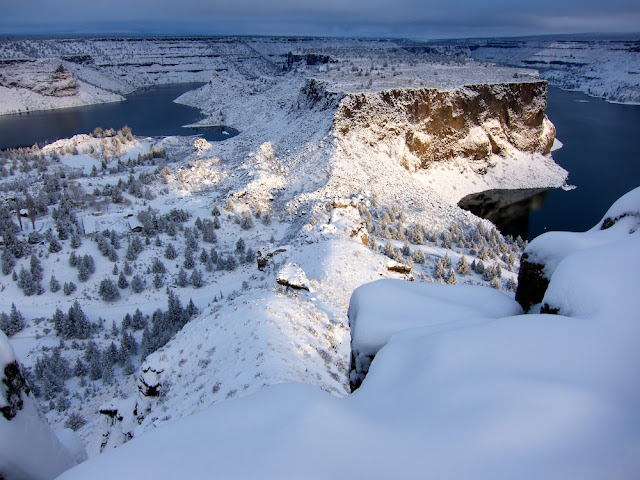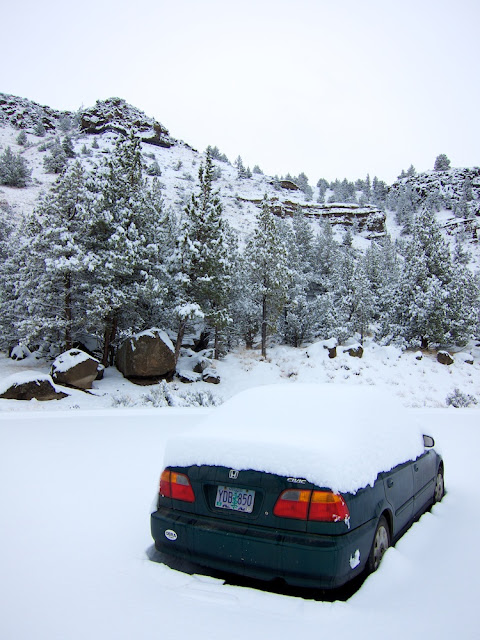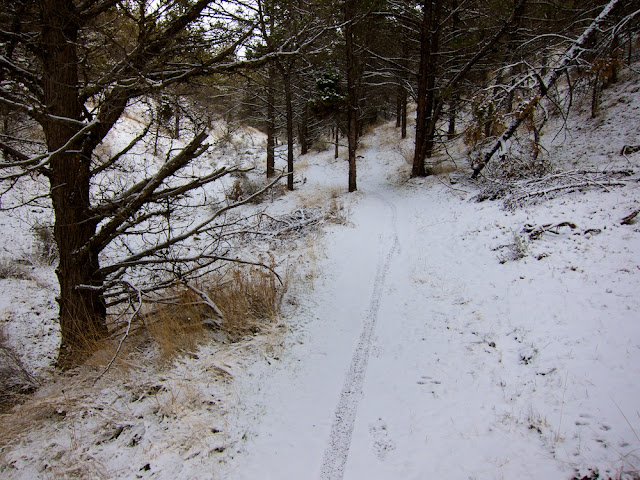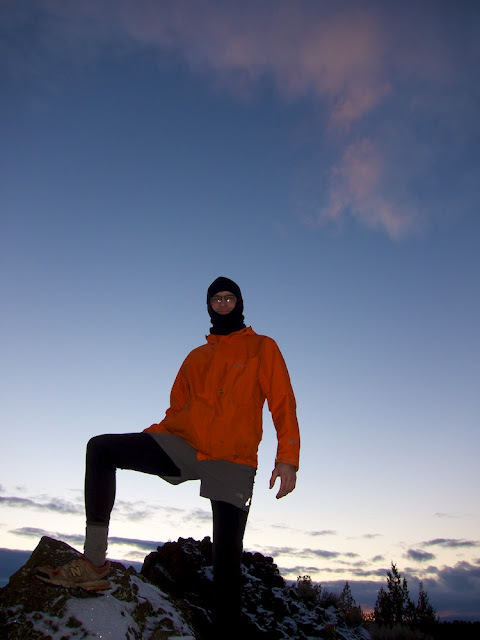Allright, here's the third and final installment of this three day trip.
I drove from the Smith Rock area north to Cove Palisades State Park. This park is recreational access to a large lake, Lake Billy Chinook, created by the Round Butte Dam. This dam backs up the water of the three main Central Oregon rivers- the Metolius, the Deschutes and the Crooked. The reservoir is huge, because is catches most of the snowmelt and percolation from thousands of square miles of the Cascades, as well as from the Ochocos, across the great wide flat valley of Central Oregon.
My first views of the lake were from my car, while driving down a steep, narrow road perched on the edge of eroded rimrock cliffs:
That's rabbitbrush in the foreground. Those bushed still have last fall's blooms on them.
I drove downhill into the park, which is situated on a narrow peninsula in between the Crooked River and Deschutes River arms of the lake. After talking to a park ranger and leaving him some money for letting me park my car overnight, I headed back up hill on a trail that leads to the Rim, the Tam-a-Lau Trail:
I wound my way up the slopes, with a moon above and the sun sometimes in my face. This was really nice, because the sun kept me warm. These photos might give the impression of warmth, but it was still only in the mid-30's this day.
Upon reaching the rim, I enjoyed panoramic views to the West, with the Deschutes below:
I also enjoyed seeing the table-top flat bench on which I would be spending the night.
As the sun set, I viewed the lake and its redrock in a wash of evening color:
The large, square edged formation in the center of this photo is called the The Island, though it is actually just part of the Peninsula. It is a protected site that supposedly has avoided the despoilment of cattle grazing, and therefore has a more of an original ecosystem than almost anywhere else in Central Oregon. Hikers are not even allowed to climb up to the top of The Island, in order to keep invasive species out.
I set up camp on the corner of this large peninsula, with views all around. There wasn't a huge sunset like the previous nights, but there was an odd shaped cloud toward the Cascades:
I cooked dinner and enjoyed the still evening air while the sunlight dimmed and moonlight took over:
After the moon was obscured by gathering clouds, I walked around the rim and took shots of several cars driving over the park road. I realized later that this road is the only paved access to a small community on the other side of the Deschutes River- sited on Canadian Bench. Turns out that this is a pretty lucky fact, because that means the road is well traveled. The large hill in the distance is Round Butte:
I slept soundly for a good while, but I woke up in the early morning. In my groggy state, I knew something was going on outside my tent. As soon as I really woke up, I realized that my tent was much smaller than I recalled.
I could see snow piled up around the tent, and peeked outside to check out the scene:
At this point, I got out of bed, cleaned off the tent, and staked it out to shed the snow a little more effectively.
The next four hours or so went basically like this: sleep a bit, wake up, then bang the inside walls of the tent to keep snow from building up too much and pushing the walls down. Over the course of the night, about 8 inches fell. It was a beautiful desert snow- very dry and light.
The most special thing about this experience was the sound of snow falling and the reaction that caused in my musician's brain: I kept hearing a pulsing chord of high pitches (I don't have perfect pitch, but I think that they were G, Bb and C, or some variation on those intervals). The tone of these pitches was crystalline and pure- rather like highly competent glass harmonica playing. I'm sure that the snow didn't sound like this.
My experience was powerful physically (cold, extreme quiet, darkness), intellectually (thinking of the crystal structures of snow flakes pressing in on the tent) and emotionally (isolation and ever-increasing concern about being able to drive out the next day, tempered by real enjoyment and confidence that I'd be okay no matter what).
My mind took this stew of my experience and composed a hypnotic musical motif as a background accompaniment. I can still hear it now, if I think about it. A real synesthetic experience!
It was still cold and uncomfortable to get up, though this was the warmest morning of the three days on my trip.
The snow made the surroundings quite different from their appearance the day before:
A little bit of a distant sunrise:
The Island:
I was, as I mentioned, not really sure how I'd get out of the park and up that crazy road to the highways on the main valley floor. My fervent desires were answered when I heard a heavy engine rumbling and heard a scraping noise down in the park: they'd fired up a big pick up with a plow, and were busily clearing the roads. That'd make the trip much easier, though I imagined (correctly) that I'd still be white-knuckling it out of there.
Yours truly, before heading back down:
Walking back down was nice, in a cold-feet but warm heart sort of way. If I'd known it would be so snowy that morning, I'd have brought better shoes and sock, as well as gaiters to keep the snow from wadding up under my heel. Oh well. . . there was nothing for it!
More transfigured views:
I could see my car down in its lot. Unfortunately, they hadn't plowed out a path for me, but they had plowed the spur road to the lot. I knew I'd have to get the car to the road somehow.
My hidden car:
I dug out with the shovel I'd brought for just this purpose. I put my chains on the front tires for traction. Then I got the car revved up and starting driving toward the spur road. Of course, when they'd plowed that road, they'd pushed up a wall of compacted snow at the edges. Luckily, my car was parked uphill of that obstacle, and with only a little tap of the gas, I barreled down the hill and busted right through the snow! It was actually quite fun.
Then the fun ended, and I spent 4 hours driving home, putting on and taking off my chains several more times (they always seemed to be on when the road was melted out, and off when there was suddenly ice and snow). There were white-out conditions for a short time, which didn't seem to bother the other drivers on the road. This really made me feel incompetent! How far I've come from my Iowa days.
I made it back without a scratch. I hope you enjoyed my trip!
Charley

























































